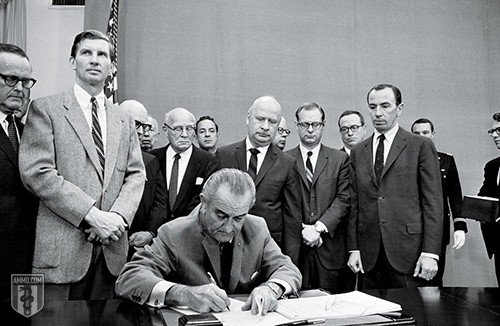Post by torpedo on Sept 2, 2019 22:11:47 GMT
Gun Control Act of 1968: Signed Into Law October 22, 1968

Three decades passed. Then, over five years, four major assassinations took their toll: President John F. Kennedy; racial activists Malcolm X and Rev. Dr. Martin Luther King, Jr.; and Senator Robert F. Kennedy. As for the assassins, Lee Harvey Oswald had purchased his rifle through a popular mail order company under an alias, Talmadge Hayer had a criminal history of stolen guns, James Earl Ray was an escaped convict, and Sirhan Sirhan had purchased his unregistered handgun from a private individual. The response was a major overhaul of restrictions on how guns could be bought and sold.
Signed by President Lyndon B. Johnson, the Gun Control Act of 1968, or Public Law 90-618, soon became known as Title I, repealing the Federal Firearms Act of 1938 and relegating the National Firearms Act of 1934 to Title II. Its stated purpose was “to provide support to Federal, State, and local law enforcement officials in their fight against crime and violence.” To that end, it:
Mandated licensing for all importers, manufacturers and dealers of firearms and ammunition involved in interstate or foreign arms commerce, and set license fees for “destructive devices” at $1,000 a year.
Prohibited using falsified information to acquire a firearm.
Set the general purchase age for handguns and handgun ammunition at 21.
Prohibited dealers and manufacturers from selling firearms to indicted or convicted individuals, fugitives from justice, drug addicts and mentally incompetent individuals.
Required registration of all firearms with the National Firearms Registration and Transfer Record.
Prohibited the possession of firearms on which the serial number has been altered, obliterated or removed.

Three decades passed. Then, over five years, four major assassinations took their toll: President John F. Kennedy; racial activists Malcolm X and Rev. Dr. Martin Luther King, Jr.; and Senator Robert F. Kennedy. As for the assassins, Lee Harvey Oswald had purchased his rifle through a popular mail order company under an alias, Talmadge Hayer had a criminal history of stolen guns, James Earl Ray was an escaped convict, and Sirhan Sirhan had purchased his unregistered handgun from a private individual. The response was a major overhaul of restrictions on how guns could be bought and sold.
Signed by President Lyndon B. Johnson, the Gun Control Act of 1968, or Public Law 90-618, soon became known as Title I, repealing the Federal Firearms Act of 1938 and relegating the National Firearms Act of 1934 to Title II. Its stated purpose was “to provide support to Federal, State, and local law enforcement officials in their fight against crime and violence.” To that end, it:
Mandated licensing for all importers, manufacturers and dealers of firearms and ammunition involved in interstate or foreign arms commerce, and set license fees for “destructive devices” at $1,000 a year.
Prohibited using falsified information to acquire a firearm.
Set the general purchase age for handguns and handgun ammunition at 21.
Prohibited dealers and manufacturers from selling firearms to indicted or convicted individuals, fugitives from justice, drug addicts and mentally incompetent individuals.
Required registration of all firearms with the National Firearms Registration and Transfer Record.
Prohibited the possession of firearms on which the serial number has been altered, obliterated or removed.
Controlled containers, markings and chains of custody for shipped firearms, eliminating mail order delivery to unlicensed individuals.











